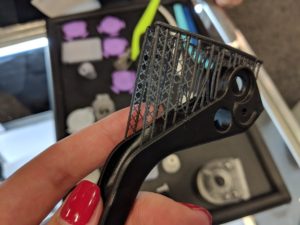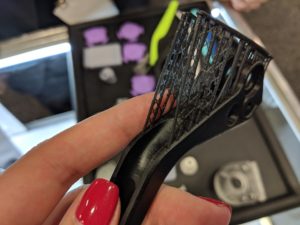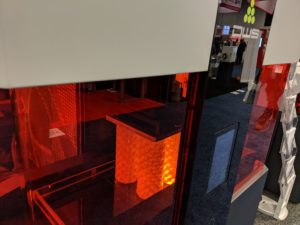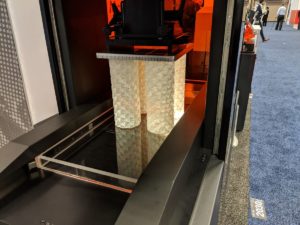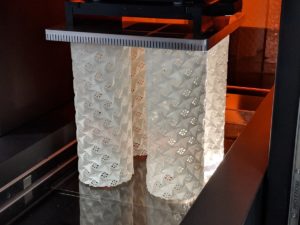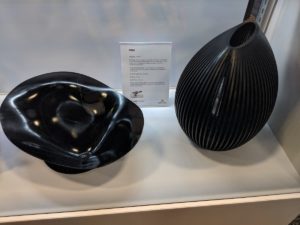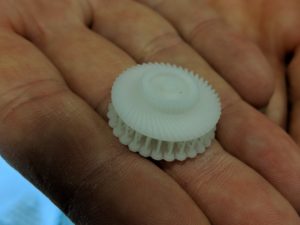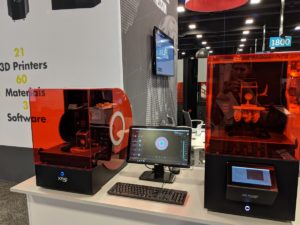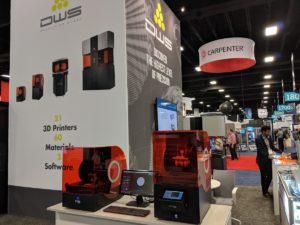 As customers gain awareness of solutions’ availability, they are increasingly seeking specific technologies to meet their needs. Among the many companies exhibiting at the recent RAPID + TCT, Italy-based DWS Systems certainly saw this to be true. With a strong portfolio of 3D printers, materials, and software, DWS has been focused on providing solutions in 3D printing. Having introduced the new XPRO S 3D printer at formnext 2017 and at CES 2018, where I appreciated the opportunity to speak to company execs and partners, the team knew the new system would be a big draw for RAPID + TCT as the 3D printing community came together in Texas. Writer Sarah Saunders and I both took the time to check the machine out in person during the week, and I enjoyed a longer conversation about this offering and DWS’ latest updates.
As customers gain awareness of solutions’ availability, they are increasingly seeking specific technologies to meet their needs. Among the many companies exhibiting at the recent RAPID + TCT, Italy-based DWS Systems certainly saw this to be true. With a strong portfolio of 3D printers, materials, and software, DWS has been focused on providing solutions in 3D printing. Having introduced the new XPRO S 3D printer at formnext 2017 and at CES 2018, where I appreciated the opportunity to speak to company execs and partners, the team knew the new system would be a big draw for RAPID + TCT as the 3D printing community came together in Texas. Writer Sarah Saunders and I both took the time to check the machine out in person during the week, and I enjoyed a longer conversation about this offering and DWS’ latest updates.
Announcing ahead of the show that the new system would be previewed at the event proved to be a strong strategy for the company, Daniela Lavezzi, Business Development and Key Account Manager, told me as we looked at the XPRO S.
“People are very interested in this new printer; there have been a lot of visitors, a lot of interest from service centers, from Tiffany, and they came here because they knew we would have this system,” she told me.
The XPRO S, she noted, is targeted toward applications in prototyping for industrial design and for functional parts. The machine’s large size (300 x 300 x 300 mm print area) and high productivity (with round-the-clock operation in mind) were designed for use in R&D departments, professional lab settings, medium and large companies, and on-demand 3D printing services. The XPRO S, with a price tag of $132,000, is set to be available for sale this month. Lavezzi walked me through the 3D printer and the software used in the process.
Nauta, DWS’ parametric software, is used for preparing files for 3D print, scaling and copying models, and preparing positioning on the platform, as well as predicting the amount of resin that will be consumed for a build. This software, Lavezzi explained, allows for automatic or manual support generation and features a patented easy support removal workflow. A part she showed me, which still had most of the support attached, did indeed show that where the connections were easily pulled away, only small dots remained at the patented break point, eliminating special tool use for removal and minimizing the need for heavy post-processing to remove telltale signs of support attachments. Following preparation using Nauta, a file is sent to DWS’ management and control software, Fictor. In Fictor, users select and configure print parameters — layer thickness, contours, hatching, etc. — and material settings.
In addition to developing software in-house, DWS produces materials and the components of its 3D printers in Italy, including the electronics, lasers, and the machines themselves. This vertical production, Lavezzi noted, offers greater control for users.
“We make our resins ourselves; we can test them thoroughly, we can parameterize them to obtain the best part,” she told me.
“The software tells the user how much resin is needed, and then you simply pour the resin into the tank, close the door, and hit print.”
DWS’ resins were developed with industrial sector use in mind; this system, the company notes, uses ABS-like, polypropylene-like, rubber-like, and transparent materials; nano-ceramic resins; materials for investment casting models and silicone molding masters; and many more.
Post-processing is fairly standard for an SLA 3D printing process, including washing parts with alcohol and setting the resins with UV light. Proving a popular option, metal finishing allows for a spray-on finishing touch to add a metallic surface.
Among the finished parts to showcase at RAPID + TCT from its portfolio of 3D printing solutions, DWS had functional parts, jewelry, toys, and home decor including lighting and a kettle. Resolution and accuracy all delivered on the promises DWS makes, and each time I’ve had the opportunity to speak with the team and see more parts, there’s more in precision to see.
Discuss DWS, industrial design, and other 3D printing topics at 3DPrintBoard.com or share your thoughts in the Facebook comments below.
[Photos: Sarah Goehrke]
Subscribe to Our Email Newsletter
Stay up-to-date on all the latest news from the 3D printing industry and receive information and offers from third party vendors.
You May Also Like
3D Printing Unpeeled: New Arkema Material for HP, Saddle and Macro MEMS
A new Arkema material for MJF is said to reduce costs per part by up to 25% and have an 85% reusability ratio. HP 3D HR PA 12 S has been...
3D Printing News Briefs, January 20, 2024: FDM, LPBF, Underwater 3D Printer, Racing, & More
We’re starting off with a process certification in today’s 3D Printing News Briefs, and then moving on to research about solute trapping, laser powder bed fusion, and then moving on...
3D Printing Webinar and Event Roundup: December 3, 2023
We’ve got plenty of events and webinars coming up for you this week! Quickparts is having a Manufacturing Roadshow, America Makes is holding a Member Town Hall, Stratafest makes two...
Formnext 2023 Day Three: Slam Dunk
I’m high—high on trade show. I’ve met numerous new faces and reconnected with old friends, creating an absolutely wonderful atmosphere. The excitement is palpable over several emerging developments. The high...



